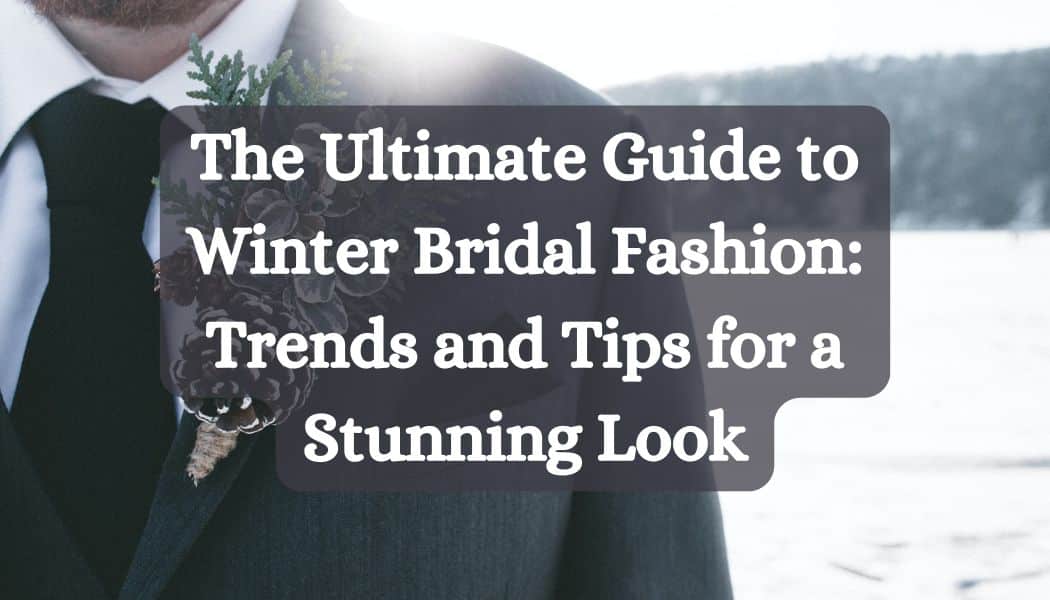
While fall is the most popular wedding season (with 43% of couples holding their events between September and November) winter still commands a significant following, with stats revealing 11% of weddings were held between December and February in 2023. (1)
The chilly weather is romantic and you can create a cozy atmosphere with proper planning. Winter weddings can also be more glamorous than summer weddings because you can decorate with rich colors that’d look ill-timed in other months.
Moreover, the heaviness of the cold and possibility of snow add a festive beauty to your wedding. Photos that include the outdoor snow aesthetic have an ethereal, nostalgic, dreamy look, which will forever be ingrained in your memories.
One downside, however, with winter weddings is the cold. There’s the possibility of freezing, either at the wedding or on your way there. Then the weather can be very unpredictable. Heavy downpours can start any time, disrupting your schedule or making you uncomfortable. And that’s why you must be careful with your outfit choice.
Below are tips to dress for a winter wedding to ensure you stay warm and still look stunning.
Table of Contents
Choosing the Right Scarf
A beautiful scarf adds some chic element to your outfit, plus a little extra comfort and warmth. But make sure to match it with your wedding dress.
A white dress goes well with a white scarf. If your dress is ivory, a scarf in the same colors will do you good. Likewise, a long, voluminous winter wedding dress looks fantastic when paired with a large scarf, while a short dress will need a smaller one.
In matters of material, cashmere leads in popularity. It’s very warm and soft, actually much softer on the skin than regular wool. It’s also longer lasting than wool, only that it may not be as strong. Moreover, cashmere is breathable and wrinkle-resistant. Italy in Cashmere stocks a large variety of these scarves (and they’re made from 100% cashmere), ensuring you can find a matching one for your wedding dress that feels luxurious.
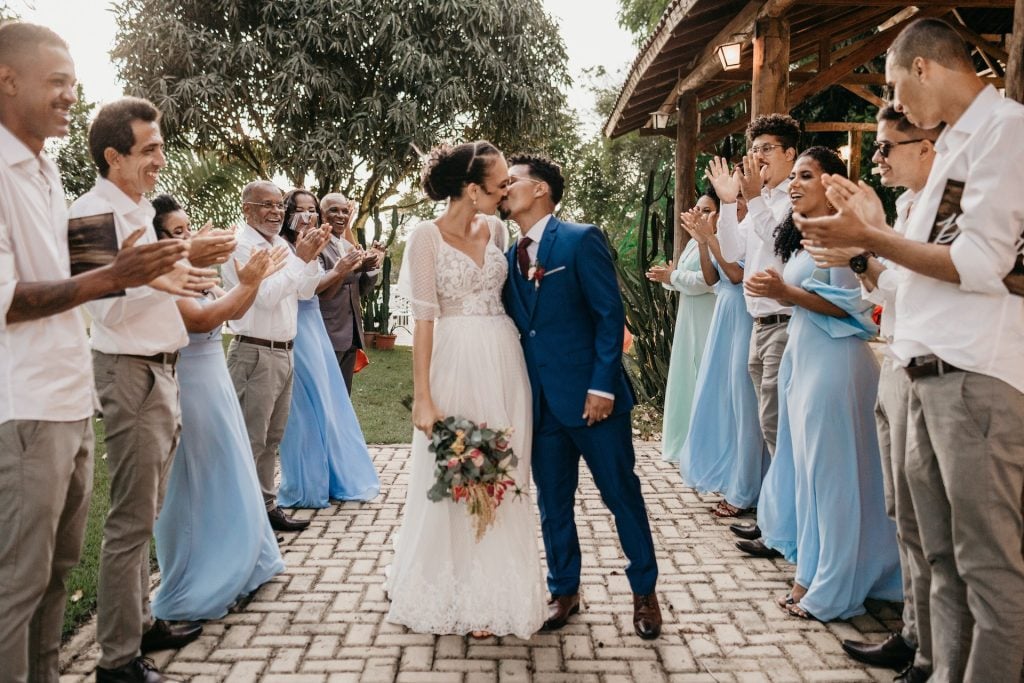
Wedding Dress
The most crucial decision when planning for your winter wedding is choosing your wedding dress.
Winter wedding dresses are obviously different from those designed for other seasons. They must keep you warm while still looking stylish.
Below are some important things to consider when choosing your winter wedding dress.
Fabric
Different fabrics have varying warmth levels. Go for thicker fabrics like the following:
- Velvet is a perfect winter wedding fabric. It has a soft luxurious texture that speaks of affluence.
- Satin is likewise luxurious, but with a smooth, glossy surface, unlike the furry one of velvet. It has an ageless appeal and works excellently for winter weddings when paired with the right accessories and layering.
- Tulle is a lightweight sheer fabric commonly used for layering. It might not provide enough warmth on its own, but it can be combined with other fabrics like satin or velvet to fit the winter weather.
- Fur or faux fur can make for excellent accents to your wedding dress. Use it as trim on the collar, cuffs, or hemline. Beyond the added warmth, fur accents create a dramatic and cozy winter look.
- Brocade is an elaborately woven fabric with paisley or floral patterns. The resulting vintage charm is perfect for winter weddings. Consider a brocade gown with metallic accents for some bit of sparkle.
- Wool is naturally an insulator, thus ideal for a winter bride. Go for wool blends that are both warm and soft on your skin for the sake of comfort.
- Trafetta is a crisp, smooth fabric made from silk or synthetic fibers. It has a glossy surface and doesn’t easily wrinkle. And given that it drapes beautifully, you can use it to add volume to your A-line wedding dress.
Don’t be afraid to try several dresses until you find the material that just feels perfect on you. The average bride tries four to seven dresses before settling on the best. (2)
Sleeves
Long sleeves are the obvious option for winter wedding dresses because of the generous coverage and warmth on your arms. They keep out the cold while also adding a decorative element to your wedding dress.
Slim three-quarter sleeves, like the one Meghan Markle wore, add a touch of refined modernity.
Alternatively, you could opt for detachable sleeves. Consider a wedding where you change from indoors to outdoors. Or where the weather gets a bit warmer at some point. With detachable sleeves, you can switch from a sleeved outfit for the formal ceremony to an off-shoulder style when it’s time to dance in the sun.
Another ideal sleeve style for winter is the bell sleeve. It’s a distinctive design where the sleeve fits snugly from the shoulder to the elbow then flares out downwards around the forearm. It adds a touch of romance and bohemian flair to your wedding gown, while also keeping you warm.

Length
A floor-length gown will help keep your legs warm during the chilly weather, one that goes almost to the floor (an inch or two above the floor) but also shows off your shoes when you walk. This also ensures you don’t mess up your dress in case the winter morning gets wet.
But you could also wear a shorter dress if that’s what you prefer. Mini or knee-length dresses show off your legs and style and add some lively fun. However, consider pairing it with tights or tall boots for added warmth.
Embellishments
Adding embellishments to your wedding dress makes it more glamorous while also providing an additional layer of warmth. Think of embroidery, intricate beadwork, or delicate lace appliques.
Embroidery is romantic, timeless, and elegant, adding a fantastic touch of texture to your gown. It has been used by brides for centuries and the trend is here to stay. Floral embroidery particularly provides breathtaking beauty, not to mention its feminine appeal.
To note, brides of the past ages could incorporate floral motifs into their gowns as a symbol of fertility, innocence, and new beginnings. And it remains a top choice for brides desiring to add aromantic whimsy or vintage charm to their wedding attire. Modern technology has made it possible to create more intricate designs, thus you can incorporate whatever style you desire.
Beads are another welcome embellishment for winter weddings. They add a touch of glamor, whether you go for glitzy sequins, iridescent pearls, or sparkly beading. A fully beaded gown looks absolutely fantastic and could be ideal for winter because of the added warmth. But you can’t ignore the weight that comes with it.
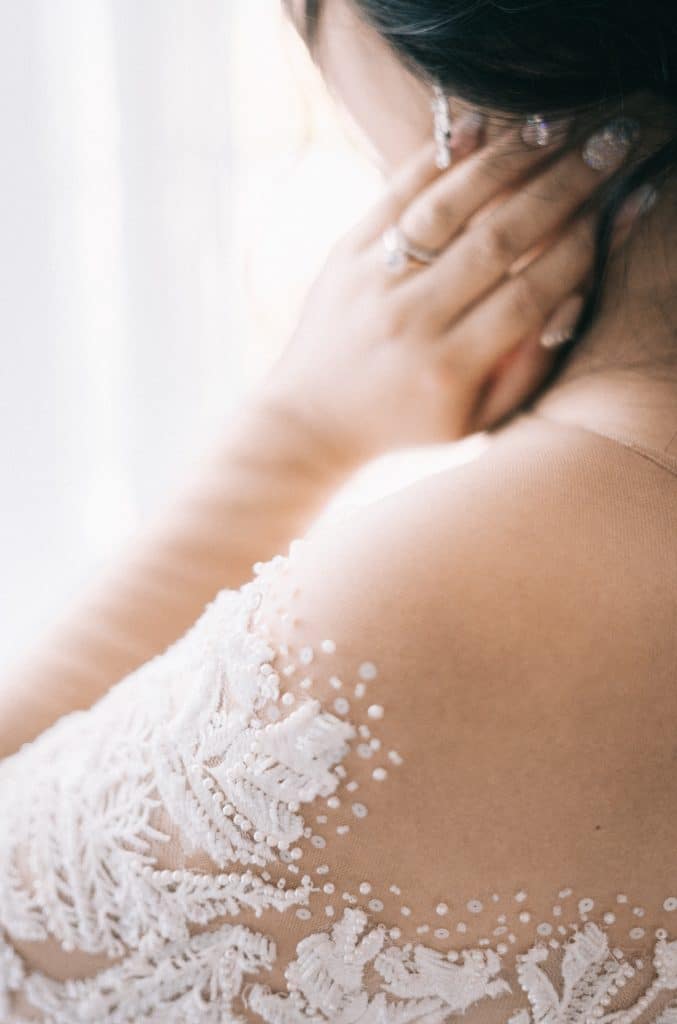
Moreover, the more beading, the more expensive the gown will be. Beading a single gown by hand can take up to six or seven months, translating to a higher price tag because of the labor costs. You may end up spending much higher than the average of USD$ 1,900 for the gown. So, you may want to consider your budget and weight preference when choosing the amount of beadwork. (3)
Silver-colored or aluminum-like finish might give an unequaled sparkle or glow. However, these can considerably change the appearance of the wedding gown. Simple, clear sequins will help retain the gown’s natural color, while also providing a beautiful shimmer. Matte-colored beads are also not advisable for winter because they may not give as much shine.
For reduced weight, you may want to use the applique technique, where the beaded design is hand-cut out and re-assembled on the gown, scattering the bead sparsely.
Layers
Layering is a fantastic approach to warming up during winter. You can have an overlay or detachable skirt that can be removed during the ceremony, perhaps when it gets warmer.
Overlays typically cover a larger portion of the dress, unlike belts, boleros, or other similar embellishments. They add visual interest to the gown, elevating its elegance and charm. The overlay must be in cohesion with the overall wedding theme and venue decor. Also, consider your dress style, body type, and personal preferences.
Tulle overlays are perfect for long-sleeved wedding dresses. These are lightweight sheer fabrics with a soft and dreamy effect, adding a note of femininity. Remember to get the length right for a more polished and professional look. Your tulle could be floor-length, tea-length, or knee-length.
Neckline
A cozy, high neckline goes a long way in enhancing your comfort. Ideal options include turtleneck and boat neck.
A turtleneck wedding gown has a high neckline that extends to the collarbone, creating a sleek and elongated silhouette that’s modest and chic. This shields your upper chest area from the chill. The soft fabric around your neck and shoulders is also cozy, making you feel at ease throughout your wedding day. Popular fabric options for turtleneck include silk, lace, satin or crepe.
On the other hand, a boat neck, also called bateau or Sabrina neckline, features a wide neckline that gracefully follows the curve of the collarbone and extends to the shoulders. It sits high on the chest and tops your shoulders, making you warm and flattering your body.
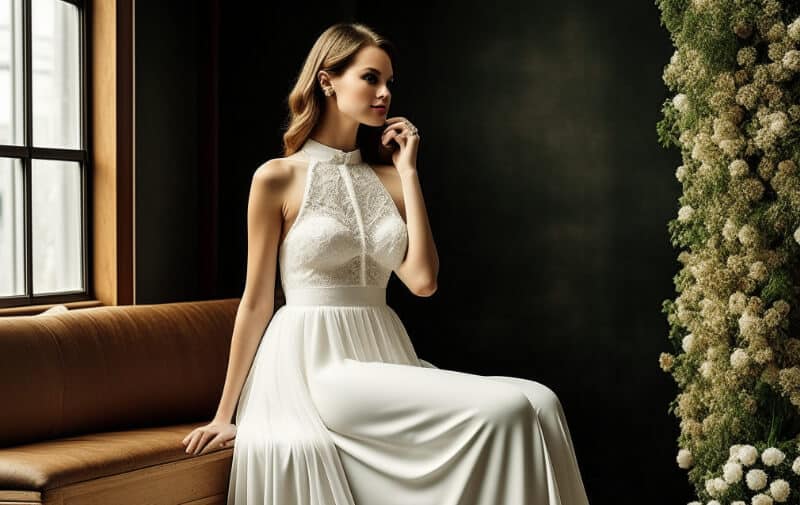
Bridal Jacket
For extremely chilly winters, you may need a bridal jacket to layer your wedding gown. The good thing is that you can remove or put it on at any time, depending on the weather.
Denim jackets are an excellent starting point. This material is pretty warm. And you can customize it with shimmery patches or fringe, perfectly complementing your white gown. A faux fur jacket is another worthwhile option. It adds texture and wintery charm to your ensemble.
If your dress is full-length, adding a long coat may seem overwhelming fabric-wise. In this case, a bolero, shawl, or wrap could be a great addition for warmth. But shorter dresses look fantastic when paired with longer coats.
Shawl
A bridal shawl is an awesome alternative to a jacket. You can simply drape it over your shoulders with the ends hanging down in the front. This style works well with long rectangular shawls. It’s more traditional and formal.
Another way to do it is folding the shawl in half diagonally and wrapping it around your shoulders with the ends crossing over in the front. You can then tie the ends in a knot or use a brooch to secure them. You can also drape a shawl over one shoulder and snugly wrap it around your torso on the opposite side. It shows off your figure, adding a flirty element to your attire despite the winter cold.
You can also veer from tradition and wear the shawl as a cape or wrap it around the arms or waist for a more modern feel.
Bridal Gloves
Bridal gloves will add a romantic twist to your winter wedding dress and enhance coziness. The length should suit your dress. Opt for short gloves if you desire a modern vibe or long, opera-length ones for a classic, dramatic look.
You’d want to harmonize the fabrics of your gloves and dress for a more refined look and seamless transition between the two. So, if your wedding dress is lacey, the gloves should at least feature a similar pattern. Generally, satin or lace gloves are more romantic and can still keep your hands warm.
For a pure white winter wedding dress, you’d want gloves in a shade of white that closely matches the gown. For off-white or ivory gown, select gloves that closely match the gown colour. And for a coloured wedding dress, you’d want gloves in a complementary shade or a neutral colour like beige or pale gray.
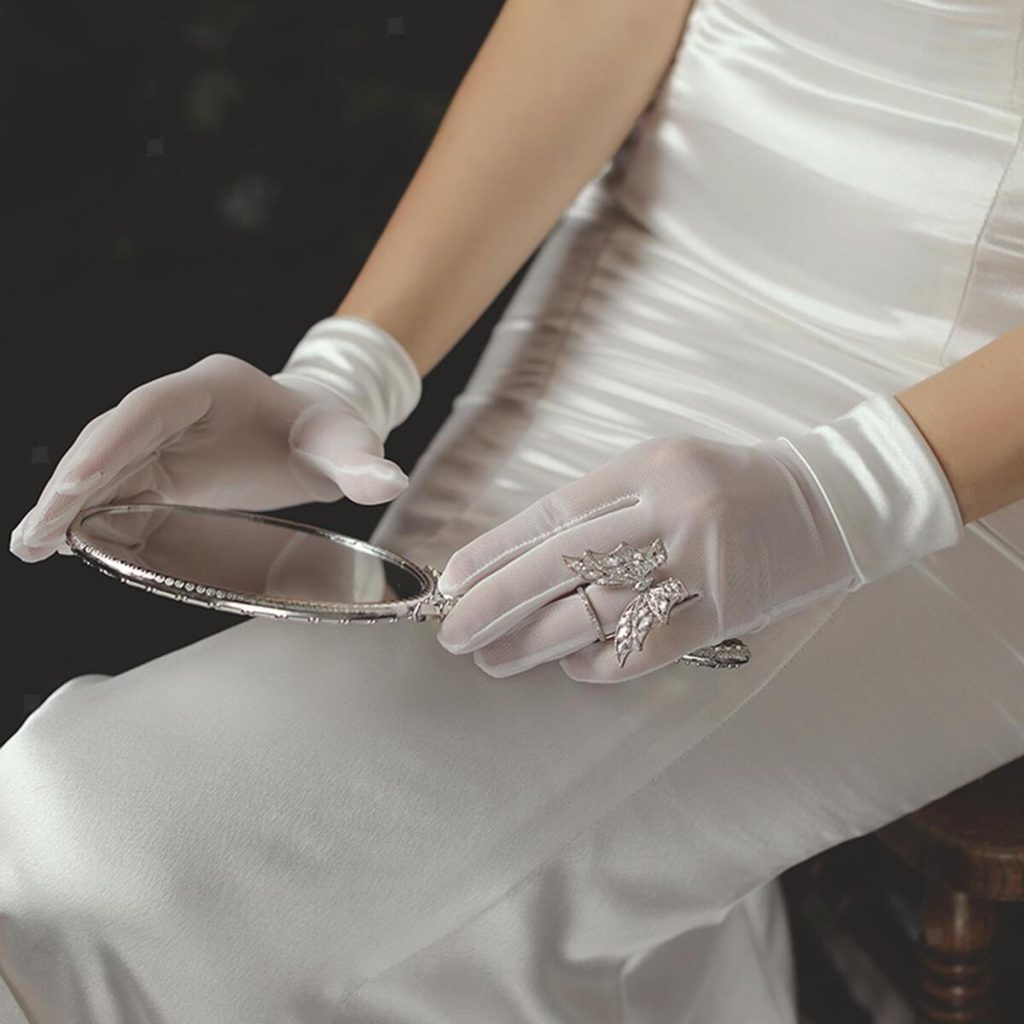
Faux Fur Stole
Fur stoles are usually worn around the neck as an alternative to a scarf. They’ve recently popped up on many a runway. Thus, adorning them adds a touch of class.
Real fur stoles can be quite expensive, the reason why faux fur is recommended. The latter is also excellent for those who prefer not to harm animals. The good thing is that faux fur stoles look as close to real fur as possible. They’re made of several layers for more thickness and fullness.
You can pair them with other fur items for a fun look. For instance, a clutch made of fur or shoes with fur embellishments. Just ensure all your fur items match in terms of color and texture.
Winter Headpiece
A beaded or crystal tiara will add some shimmer to your winter bridal look, although not necessarily adding warmth. If well chosen, they can be the crowning touch to your overall bridal look. Popular styles include the wishbone, regal, double band, headband, and wreath tiaras.
Your first consideration ought to be that the tiara should complement, not compete, with the dress. Keep the tiara on the minimalist side so as not to steal focus from the dress. If your dress has pearls, a tiara with similar decor will look beautiful. And if the dress has some particular hue, consider incorporating the same into the tiara.
Boots
Finally, pair your wedding dress with stylish boots. While strappy sandals might be your dream, they may not be appropriate for a winter wedding because of the cold and possible wetness.
Wedding gowns can also look ethereal when paired with boots. What’s more, they offer more stability. It’ll be easy to walk with them on all kinds of terrain, be it sandy, mud, dirt, leaves, or grass.
Winter wedding boots should ideally be warmer, more water-resistant, and less strappy. Those with faux fur trim can keep your feet cozy while looking perfectly bridal.
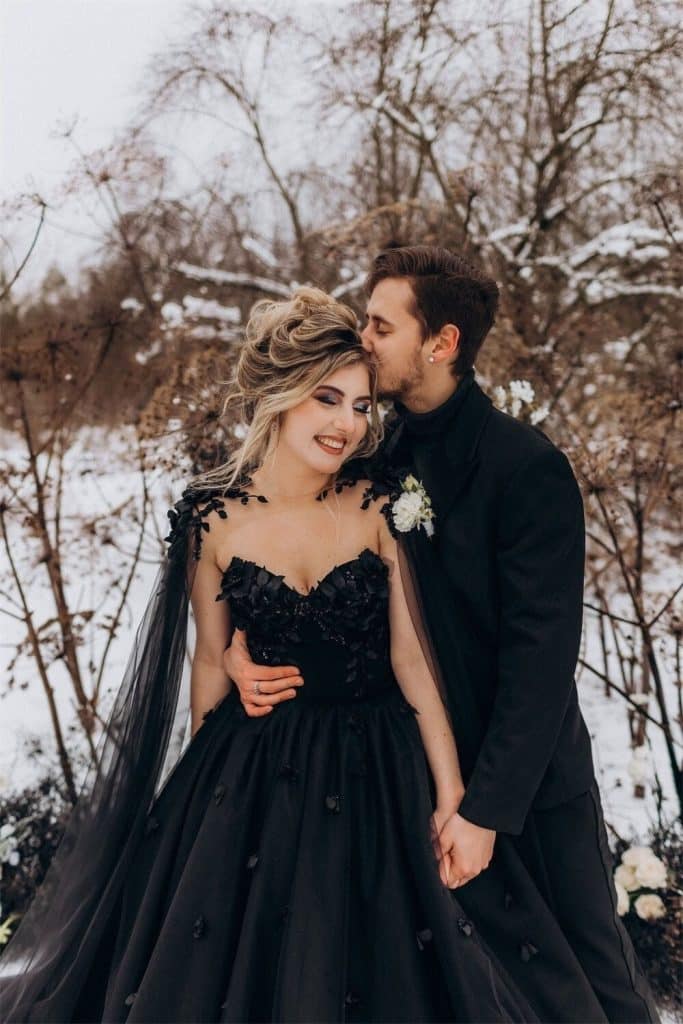
Conclusion
Winter weddings can be stylish and fun despite the gloomy weather. The tips outlined herein are an excellent starting point for choosing your bridal outfits. Don’t be afraid to experiment until you find what works best for you. Working with professional stylists could also help. They’ll give you sure-fire tips guaranteed to give you a stunning look.
References
- When Is Wedding Season? Here Are the Most Popular Wedding Months. Source: https://www.theknot.com/content/is-there-an-off-season-for-weddings
- Wedding Dress Industry Statistics: Market Data Report. Source: https://gitnux.org/wedding-dress-industry-statistics/
- What Is the Average Cost of a Wedding? Source: https://www.investopedia.com/wedding-average-cost-8558593












